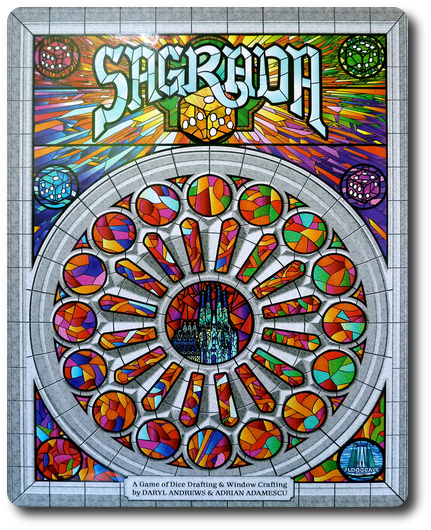
The Basics:
- For ages 10 and up (publisher suggests 13+)
- For 1 to 4 players
- Approximately 40 minutes to complete
Geek Skills:
- Counting & Math
- Logical & Critical Decision Making
- Reading
- Pattern/Color Matching
- Strategy & Tactics
- Risk vs. Reward
- Hand/Resource Management
Learning Curve:
- Child – Easy
- Adult – Easy
Theme & Narrative:
- Build a beautiful stained glass window
Endorsements:
- Gamer Geek approved!
- Parent Geek approved!
- Child Geek approved!
Overview
The Sagrada Família is a large Roman Catholic church is Spain that began construction in 1882. To date, it’s not yet complete and for good reason. The project has suffered missteps, political problems, financial issues, and even a fire. Throughout it all, the building remained and grew, becoming a breathtaking example of Gothic architecture with beautiful stained glass windows. Now you have an opportunity to participate in its construction.
Sagrada, designed by Adrian Adamescu, Daryl Andrews and published by Floodgate Games, is comprised of 4 Window Frame player boards, 12 Window Pattern cards, 12 Tool cards, 10 Public Objective cards, 5 Private Objective cards, 90 standard six-sided dice (in 5 different colors, 18 per color), 4 Score markers, 24 Favor tokens, 1 dice bag, and 1 Round Track/Score Track board. The game component quality is excellent. The Window Frame player boards have recessed square holes that allow the dice to sit comfortably with zero chance of being disturbed once placed. An excellent design touch.
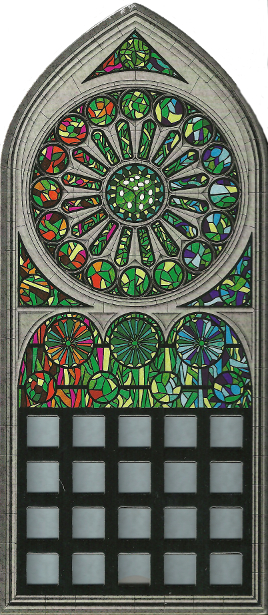
Game Set Up
To set up the game, first shuffle the Private Objective cards and deal 1 to each player, face-down. Players should keep this card as secret as possible during the game until the end. Any undealt Private Objective cards should be returned to the game box.
Second, shuffle the Window Patter cards and deal 2 to each player. Each player selects one of the two Window Pattern cards to use and the side they want to play with. Place the remaining Window Pattern cards back in the game box.
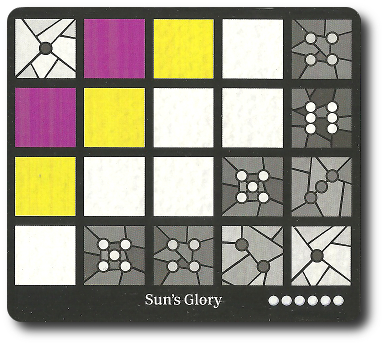
Third, hand to each player 1 Window Frame player board. Players slip their selected Window Pattern card into their Window Frame player board using a slot on the bottom. Give to each player at this time a number of Favor tokens as indicated by the player’s selected Window Pattern card. The remaining Favor tokens can be placed back in the game box.
Fourth, place the Round Track/Score Track board in the center of the game playing area with the Round Track side face-up. Place a Score marker for each player next to the track.
Fifth, shuffle the Tool cards and deal 3 face-up in the center of the playing area. Place the remaining Tool cards back in the game box.
Sixth, shuffle the Public Objective cards and deal 3 face-up in the center of the playing area underneath the three previously placed Tool cards. Place the remaining Public Objective cards back in the game box.
Seventh, place all 90 dice in the dice bag and mix them up.
That’s it for game set up. Determine who will be the first player and give them the dice bag.
Of Color and Light
Sagrada is played in rounds and turns for a total of 10 rounds per game. A game round is summarized here.
Step 1: Draw Dice
The first player (the player who is currently holding the dice bag) draws a number of dice determined by the number of players. In total 2 dice will be drawn per player, plus 1 additional die. For example, a 2-player game will result in 5 dice being drawn and a 4-player game will result in 9 dice being drawn.
The dice are now rolled to create the Draft Pool.
Step 2: Select Dice/Use Tools
Starting with the first player and continuing in turn order sequence, each player will take a turn completing two actions in any order they determine to be best. Both actions are optional, meaning the player can take two, one, or no actions on their turn. The actions are as follows:
Action One: Select One Die
The player may select any die from the Draft Pool they like. When taken, the number value rolled cannot be changed. The die is immediately placed in the player’s Window Frame player board. The first die to be placed must be placed on any of the window frame’s edges or corners. The second and subsequent dice must be placed diagonally or orthogonally to previously placed dice in the window frame. The newly placed die must match the color or shade of the window frame space as indicated by the Window Pattern card (white spaces mean no restrictions). For example, a blue space on the Window Pattern card can only be used by a blue die (of any number value) and a space that shows a “3” can only be used by a die with the value of a rolled “3” (with any color). The last rule is that a die may never be placed orthogonally adjacent to a die of the same color or the same number value. For example, two blue dice cannot be next to each and two dice with the same number value cannot be next to each other.
If a player is ever found to have placed a die or dice incorrectly, they must immediately correct the errors by removing as many dice as necessary until their Window Frame player board is no longer found to be incorrect. Removed dice are not returned to the Draft Pool. Instead, they are out of play for the duration of the game.
Action Two: Use One Tool Card
The 3 Tool cards can be used by any player, but it will cost the player Favor points in order to do so. The Tool cards provide the player with additional abilities not otherwise provided by default. If the player wants to use the ability noted on the Tool card, they place the correct number of Favor tokens on the Tool card and then use the ability the Tool card provides, but they must use it on their turn. Players cannot pay for Tool card abilities for use on subsequent turns.
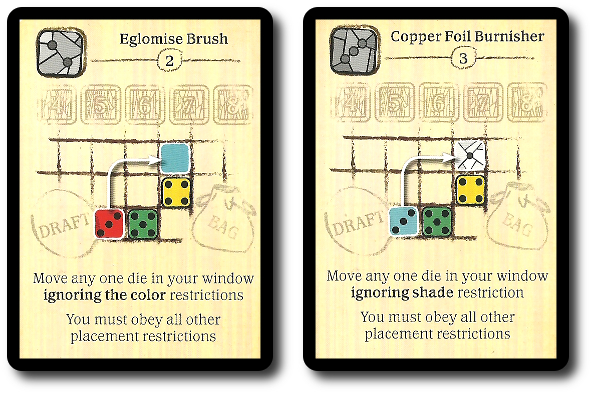
Step 3: Continue in Reverse
After the last player in turn order sequence takes their turn, the turn order reverses. The last player to go now becomes the first player and step 2 is repeated.
Step 4: End of Round
The round ends when the first player takes their second turn (in this case, the first player takes both the first and the last turn of each round).
The remaining dice in the Draft Pool are now placed on the Round Track board, covering up the numbered space that matches the current round. Regardless of the number of dice left in the Draft Pool, only one number on the Round Track is covered per end of round.
The dice bag is then passed to the next player in turn order sequence and a new round begins as noted above.
Ending the Game
The game ends when the 10th and final round is completed. All the dice on the Round Track are cleared and the Round Track is turned over to the Score Track side. The player’s Score markers are now used to track the points earned during the game. Points are earned as follows:
Players earn points by completing Public Object card requirements. Points can be earned by these cards multiple times.
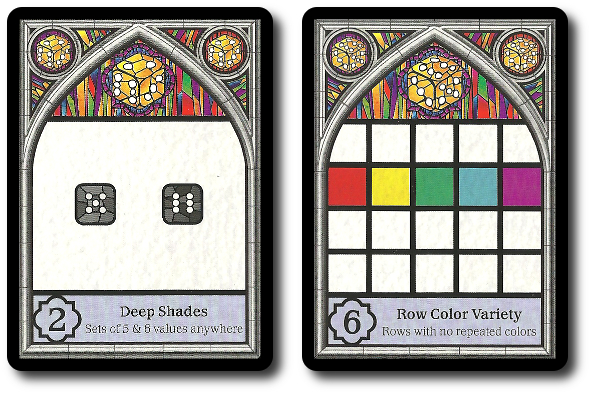
Players earn points for completing their Private Objective card requirements.
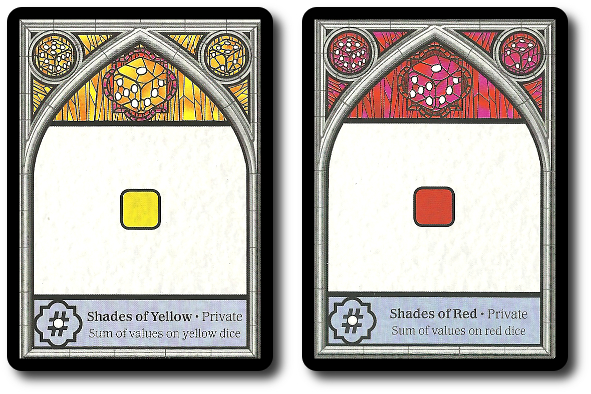
Players earn one additional point per Favor token they still have in their possession.
The players add up all their points and the player with the most points wins the game.
Game Variant
Sagrada can be played as a solitaire game. Instead of attempting to beat the score of your opponents, the goal is to beat a fixed target score. The target score is determined by the total sum of the dice placed on the Round Track. As such, it behooves a player to always select the dice with the highest number value whenever possible. Additional changes include the use of Tool cards and the total number of objectives that are available. This makes for a very challenging game.
To learn more about Sagrada, visit the game’s web page.
Final Word
 The Child Geeks, who are always ready to roll some dice, jumped right in and took to the game immediately. As one Child Geek put it, “I love how the dice fit on your board and how colorful everything looks.” The game was found to be very aesthetically pleasing, as well as fun. The only problems we ever had were when one player took the dice another player wanted or needed. But to be fair, a gamer is never left without options. According to one Child Geek, “This is a puzzle that you can solve different ways.” Very well put, but also a bit misleading. Players gain points by building their stained glass correctly, but how they go about that task is open to different approaches. This means a player is never left empty-handed, but the value returned for each action taken on their turn is always different. Which really meant nothing to the Child Geeks, as they were too busy having fun to care. When all the windows were made, all the Child Geeks voted to approve Sagrada.
The Child Geeks, who are always ready to roll some dice, jumped right in and took to the game immediately. As one Child Geek put it, “I love how the dice fit on your board and how colorful everything looks.” The game was found to be very aesthetically pleasing, as well as fun. The only problems we ever had were when one player took the dice another player wanted or needed. But to be fair, a gamer is never left without options. According to one Child Geek, “This is a puzzle that you can solve different ways.” Very well put, but also a bit misleading. Players gain points by building their stained glass correctly, but how they go about that task is open to different approaches. This means a player is never left empty-handed, but the value returned for each action taken on their turn is always different. Which really meant nothing to the Child Geeks, as they were too busy having fun to care. When all the windows were made, all the Child Geeks voted to approve Sagrada.
 The Parent Geeks found Sagrada to be a perfect combination of casual game playing and puzzle solving. They liked how each player’s main goal was to complete their own individual puzzle, but the element of competitiveness drove the would be puzzle solver to take risks. According to one Parent Geek, “The game gives you a blueprint to follow. From there, it steps back and lets the player do what they think is best. I like that.” The game gives each player an excellent base on which to build their strategy, but that’s it. From the very first moment the game begins, the player is on their own to make their own choices. What many Parent Geeks found to be exceptional is that the game, no matter how hard you think your puzzle is, always finds a way to get you back on course. “The game wants you to win,” said a Parent Geek. This sentiment was shared by all our Parent Geeks resulting in a very positive endorsement.
The Parent Geeks found Sagrada to be a perfect combination of casual game playing and puzzle solving. They liked how each player’s main goal was to complete their own individual puzzle, but the element of competitiveness drove the would be puzzle solver to take risks. According to one Parent Geek, “The game gives you a blueprint to follow. From there, it steps back and lets the player do what they think is best. I like that.” The game gives each player an excellent base on which to build their strategy, but that’s it. From the very first moment the game begins, the player is on their own to make their own choices. What many Parent Geeks found to be exceptional is that the game, no matter how hard you think your puzzle is, always finds a way to get you back on course. “The game wants you to win,” said a Parent Geek. This sentiment was shared by all our Parent Geeks resulting in a very positive endorsement.
 The Gamer Geeks felt that Sagrada was pretty to look at, but were not of the same mind when it came to the game play. According to one Gamer Geek, “This is essentially a solo puzzle that injects competitive game play via a shared and limited resource. Not bad, but I want to make sure we are all seeing the same thing here.” Another Gamer Geek said, “The game is lighter than I would like, but it moves along at a good clip and I can tell it has a lot of replay value since everything is randomized.” A few of the Gamer Geeks found Sagrada to be flat out boring, but the majority felt that the game was light enough to be a filler and had enough depth to keep them interested. A few even suggested it was the best puzzle game they had played, since it had elements of drafting components (in this case, dice). In the end, the Gamer Geeks were generally pleased but stopped short of saying Sagrada was a “great game”. Instead, they opted to suggest it was “pretty good”, which is a Minnesota way of suggesting the game was enjoyable in a non-threatening and general kind of way. The Gamer Geeks voted to approve Sagrada.
The Gamer Geeks felt that Sagrada was pretty to look at, but were not of the same mind when it came to the game play. According to one Gamer Geek, “This is essentially a solo puzzle that injects competitive game play via a shared and limited resource. Not bad, but I want to make sure we are all seeing the same thing here.” Another Gamer Geek said, “The game is lighter than I would like, but it moves along at a good clip and I can tell it has a lot of replay value since everything is randomized.” A few of the Gamer Geeks found Sagrada to be flat out boring, but the majority felt that the game was light enough to be a filler and had enough depth to keep them interested. A few even suggested it was the best puzzle game they had played, since it had elements of drafting components (in this case, dice). In the end, the Gamer Geeks were generally pleased but stopped short of saying Sagrada was a “great game”. Instead, they opted to suggest it was “pretty good”, which is a Minnesota way of suggesting the game was enjoyable in a non-threatening and general kind of way. The Gamer Geeks voted to approve Sagrada.
 The only gamers who are going to have a hard time with Sagrada are those who are colorblind. If you have difficulty matching colors on the Window Pattern cards to the available dice, you are out of luck. Everyone else should have a good time, if that individual enjoys a good puzzle. Sagrada is first and foremost a puzzle game. That’s why it’s so easy to play alone. When you add in the competitive element and the very real possibility that the dice you want might be taken from you, the game takes an interesting turn. Imagine, if you will, that you are attempting to complete a 200 piece puzzle. Not a daunting task, but if a piece of that puzzle were to go missing each time you selected a piece to use, the act of puzzle solving turns into a different exercise altogether. No longer is the player promised all the pieces they need. When selecting a die, the player must take into account not only what is available to them, but also the importance. It’s very possible that an available die is the center piece of their puzzle. The trick is knowing it and claiming it in time.
The only gamers who are going to have a hard time with Sagrada are those who are colorblind. If you have difficulty matching colors on the Window Pattern cards to the available dice, you are out of luck. Everyone else should have a good time, if that individual enjoys a good puzzle. Sagrada is first and foremost a puzzle game. That’s why it’s so easy to play alone. When you add in the competitive element and the very real possibility that the dice you want might be taken from you, the game takes an interesting turn. Imagine, if you will, that you are attempting to complete a 200 piece puzzle. Not a daunting task, but if a piece of that puzzle were to go missing each time you selected a piece to use, the act of puzzle solving turns into a different exercise altogether. No longer is the player promised all the pieces they need. When selecting a die, the player must take into account not only what is available to them, but also the importance. It’s very possible that an available die is the center piece of their puzzle. The trick is knowing it and claiming it in time.
Sagrada is easy to learn, with the hardest part of the game play being the rules to how the dice are placed. After that, the only hiccup a player will have is keeping their objectives in the proper order of severity. Players should expect their plans to go awry, but there are always alternative paths to take. Making use of the Tools is important and there is always enough information given to the players at the table to help them make informed choices. The game really does want you to win and have a good time. The only problem is, not everyone can win.
Due to just about everything in Sagrada being determined randomly, the game is different each time you play it. This gives the game a lot of longevity. Clocking in at about an hour (in most cases), Sagrada stays just long enough at the table to satisfy the gamer in you and promises to be a totally different game with new challenges the next time you get it to the table. That feels very rewarding, as you know that each time you play the game, a new challenge and experience is a very strong possibility.
Sagrada was found to be a “pretty good” game by the majority of our players and enjoyed by everyone except this one guy who I’m pretty sure hates all games by default. Unless you are like this curmudgeonous gamer with a surly temper and penchant for being grumpy, I have no doubt you’ll enjoy the game. It’s the perfect mix of puzzle solving, competitive game play, and beauty. Do try Sagrada when the opportunity presents itself.
This game was given to Father Geek as a review copy. Father Geek was not paid, bribed, wined, dined, or threatened in vain hopes of influencing this review. Such is the statuesque and legendary integrity of Father Geek.




Pingback: The Whatnot Cabinet Game Review - Father Geek